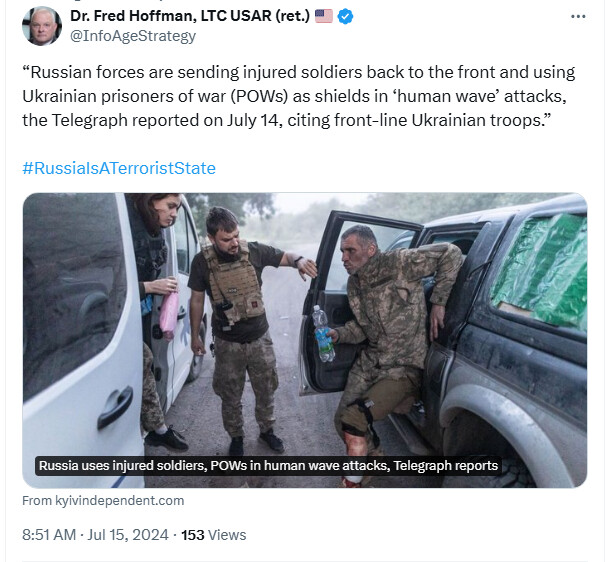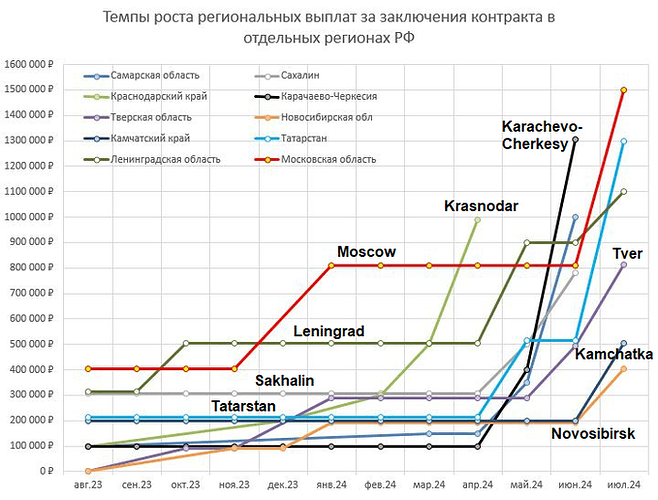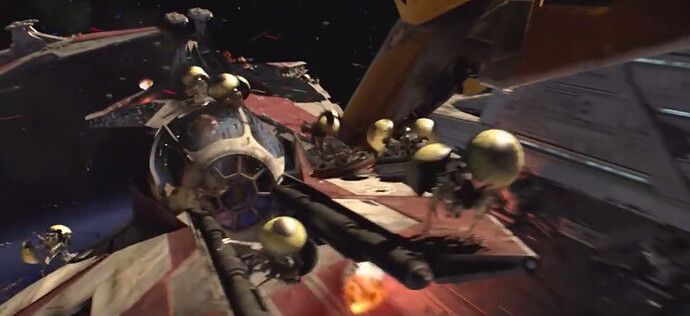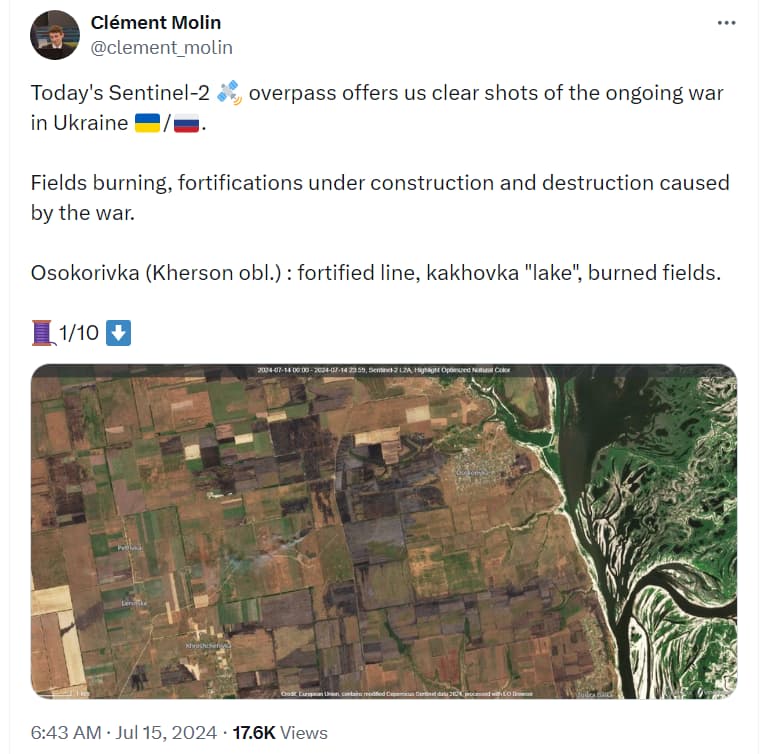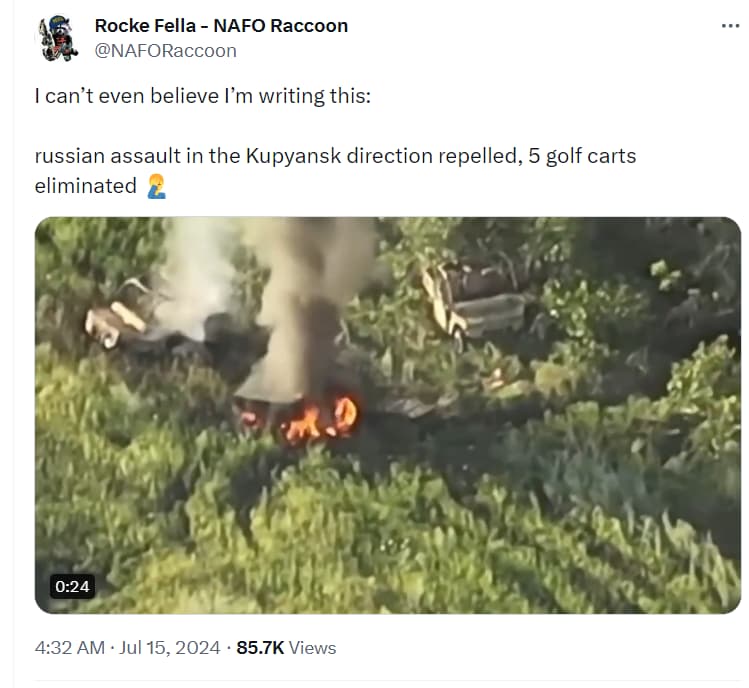The arrival of the F16s can’t come soon enough if it stops the RU air force from deploying these deadly bombs. If not them, then some long range surface to air missiles that can take them out.
F-16 is unlikely to be used much at the front as the training, older radars and older model missiles won’t be able to contest Russian air superiority. They’ll largely start their service intercepting cruise missiles and drones.
Germany is sending truck mounted Patriot batteries, these are the ideal system for SAMbushes. They can only be used once every few weeks though as the surprise factor is the main reason they can survive the attack.
Some long range drone hits of RU planes on the ground are called for… again.
How To Blow Up Russia’s Turtle Tanks: Hit Them With Two Drones In A Row
Back-to-back drone strikes can penetrate a turtle tank’s armored shell.
Desperate to clear mines in the no-man’s-land between Russian and Ukrainian positions—and equally desperate to protect the mine-clearers from Ukraine’s explosive first-person-view drones—the Russian military devised a new kind of vehicle this spring.
It’s an up-armored tank with mine-exploding rollers and shed-like improvised armor to shield the crew, and any infantry passengers, from FPV drones. Ukrainian troops derisively call the up-armored tanks “turtle tanks”—and refer to the hastily applied sheet metal and grills as “barbecue armor.”
As soon as the turtle tanks first began crawling along the 700-mile front line of Russia’s wider war on Ukraine in April, the Ukrainians began devising ways of destroying them.
A direct hit by an artillery shell, anti-tank missile or uncleared mine can do the trick. And so can back-to-back strikes by the very FPV drones the turtle tanks were designed to defeat, as the Ukrainian 108th Territorial Defense Brigade demonstrated recently.
On or before Saturday, the brigade’s SkyForce drone group spotted a T-62 turtle tank along the front line in southern Ukraine—and aimed at least two of their bird-sized FPVs at it.
“The Russian occupiers firmly believe that if a protective structure of the barbecue type is welded on top of the tank, it will provide guaranteed protection against drones,” the 108th Territorial Defense Brigade explained on social media. “But operators of the SkyForce group … prove that this is not the case at all.”
As a surveillance drone observed from high overhead, one FPV struck the tank on its metal-encased flank. Soon, a second FPV zoomed in—apparently aiming for the same side. The strikes triggered a blaze that consumed the tank.
“Double defeat,” is how the 108th Territorial Defense Brigade described the back-to-back strike tactic.
The method makes sense. Many of the best anti-tank missiles have “tandem” warheads with two explosive charges. The first charge punches a hole in a tank’s armor. The second charge explodes inside the tank in order to inflict maximum damage.
The SkyForce group’s double-defeat method for striking turtle tanks transforms a pair of FPVs into a de facto tandem warhead. One drone to make a hole in the outermost armor. A second drone to deliver a blow underneath the shattered shell.
Whether other brigades can coordinate their drones to land one-two hits remains to be seen. It’s also unclear whether all turtle tanks are equally vulnerable to tandem strikes.
After all, not all of the up-armored tanks are equally crude. Some wear truly improvised armor made of whatever scrap metal the crew could scrounge. Others have add-on armor that’s obviously carefully designed and installed—and may offer much better protection.
Strong indicators that Russia is struggling to recruit numbers needed and is drastically increasing signing bonuses.
This may answer why more aircraft aren’t being hit while on the ground @Captain_Jack
Russian Spy Drones Targeting Ukraine’s HIMARS Curb Crimea Attacks
Kyiv has decreased the number of its missile attacks on Crimea because Russian drones are allowing Moscow to scope out Ukrainian artillery such as U.S-supplied HIMARS (High Mobility Artillery Rocket System), it has been reported.
Since Vladimir Putin’s invasion, Ukraine has hit numerous Russian military targets in the peninsula—which has been occupied since 2014—recently using British Storm Shadow missiles as well as HIMARS to deliver headline-grabbing strikes.
But the pro-Ukrainian news outlet Politika Strani (Politics of the Country) said the number of Kyiv’s attacks in Crimea had dwindled in recent weeks because of the effectiveness of Russian reconnaissance unmanned aerial vehicles (UAVs).
“There is one problem that threatens the use of HIMARS striking Crimea—the recent activation of Russian reconnaissance drones,” Politika Strani said on its Telegram channel in a post next to a map of the Crimean region.
On July 8, the Russian military said it had taken out three HIMARS launchers in the Kherson region, with drone footage showing the purported strike, which has not been confirmed by Kyiv.
Politika Strani said for Ukraine to use ATACMS missiles against the Crimean city of Sevastopol—a Black Sea Fleet hub—HIMARS would be needed around Mykolaiv (Nikolaev) around 170 miles away. But Russian reconnaissance drones were able to reach this area, as well as neighboring Odesa.
Russian drones are “extremely active tens of kilometers from the front line” the post said, which poses a “high risk” to HIMARS installations, it said.
“This does not mean that the Armed Forces of Ukraine will abandon strikes on Crimea,” but Russia’s use of drones “is forcing Ukrainian forces to be more cautious about using HIMARS near the front line.”
Drone on drone wars are coming.
https://apnews.com/article/russia-ukraine-war-treason-crackdown-d5dc9840d3f4d46cd394044640031e4e
Scientists, a journalist and even a bakery worker are among those convicted of treason in Russia
TALLINN, Estonia (AP) — Over the past decade, Russia has seen a sharp increase in treason and espionage cases.
Lawyers and experts say prosecutions for these high crimes started to grow after 2014 — the year that Russia illegally annexed the Crimean Peninsula from Ukraine. That’s also when Moscow backed a separatist insurgency in eastern Ukraine.
The number of treason and espionage cases in Russia really spiked after the Kremlin sent troops into Ukraine in February 2022, and President Vladimir Putin urged the security services to “harshly suppress the actions of foreign intelligence services (and) promptly identify traitors, spies and saboteurs.” The crackdown has ensnared scientists and journalists, as well as ordinary citizens.
A look at some treason cases prosecuted in Russia in recent years:
Oksana Sevastidi
In April 2008, bakery worker Oksana Sevastidi saw military equipment on the railway near Sochi, the Russian Black Sea resort where she lived. She texted a friend who lived in neighboring Georgia about it. Weeks later, in August, the two countries fought a brief war, which ended with Moscow recognizing South Ossetia and another Georgian province, Abkhazia, as independent states and bolstering its military presence there.
Sevastidi was arrested in 2015, stemming from her text messages, and convicted of treason the following year. The case made national headlines after Ivan Pavlov and Evgeny Smirnov, prominent lawyers specializing in treason cases, took it on in 2016. That same year, Pavlov’s team revealed that several other Sochi women were convicted of treason in eerily similar cases.
President Vladimir Putin was asked about Sevastidi at his annual news conference in December 2016. He called her sentence “harsh” and promised to look into it, saying that “she wrote what she saw” in her texts and that it didn’t constitute a state secret. In 2017, Putin pardoned Sevastidi and two other women.
Ivan Safronov
Ivan Safronov, a former journalist who went on to work for the Russian space agency Roscosmos, was arrested in 2020 and accused of passing military secrets to Czech intelligence and a German national. In September 2022, a court in Moscow convicted him of treason and sentenced him to 22 years in prison.
Safronov rose to prominence as a military affairs reporter for Kommersant, a leading business newspaper. He vehemently rejected the charges against him, arguing that he collected all the information from open sources as part of his journalistic work and did nothing illegal.
Colleagues denounced the verdict as unfounded and pushed for Safronov’s release, suggesting authorities may have wanted to punish him for his reporting about military and space incidents and arms deals.
His fiancee, Ksenia Mironova, told The Associated Press that she believes such treason cases, which are investigated in secret with trials held behind closed doors, are convenient for law enforcement because their accusations can go unchallenged:
“They don’t have to explain anything to anyone at all. Not that they bother anyway. … But (with open trials), there is still a chance that some unfortunate journalists will come and write something. With treason, the case is closed, and they can just concoct something, and that’s it,” said Mironova, who also is a journalist and has reported on the rise of treason prosecutions.
Valery Golubkin
Valery Golubkin, now 71, was a physicist specializing in aerodynamics when he was arrested in 2021 and convicted of treason in June 2023. He was sentenced to 12 years in a maximum-security prison.
According to his lawyers, the authorities accused Golubkin of sharing state secrets with a foreign country. The scientist and his defense team argued that he merely submitted research reports on an international project of a hypersonic civilian aircraft that his state-run institute was involved in.
The reports didn’t contain state secrets and were vetted in accordance with regulations before they were sent abroad, according to lawyer Smirnov.
In a letter from behind bars to the Russian news outlet RBK in 2021, Golubkin said the project in question was approved by the Trade Ministry, and that the charges against him are based on the testimony of his supervisor, Anatoly Gubanov, who was arrested several months before Golubkin.
Gubanov, 66, also was convicted of treason and sentenced to 12 years in prison in 2023.
Lawyers for Golubkin appealed his verdict and lost. In April 2024, the Supreme Court overturned the ruling on the appeal and ordered another review of it, but in the end, the original sentence was upheld.
His daughter, Lyudmila Golubkina, told AP that neither the family nor Golubkin have had high expectations after the Supreme Court ruling, and they now hope he can be released on parole after serving two-thirds of his sentence.
“When a person has something to live for, a goal, it helps them to overcome everything,” she said. “I hope we will still get to see him a free man.”
Igor Pokusin
Igor Pokusin, a 62-year-old retired pilot who was born in Ukraine, was arrested in the southern Siberian city of Abakan, for protesting Russia’s 2022 invasion of his native land. He was convicted of vandalism and sentenced to six months of parole-like restrictions.
He later was arrested again on the more serious charge of “preparing for treason,” according to the First Department, a rights group that investigates treason cases.
The charges against him stemmed from his phone calls to relatives and friends in which he mulled moving to Ukraine and volunteering as a pilot there to ferry the wounded or deliver humanitarian aid, according to the rights group and media reports.
In January 2024, Pokusin was convicted of the “preparing for treason” charge and sentenced to eight years in prison. The First Department said he died behind bars in June.
Advocates from Memorial, Russia’s oldest and most prominent human rights group, have declared Pokusin, Sevastidi, Safronov and a number of others accused of treason to be designated as political prisoners.
Yes, who would of thought on Feb 24th 2022 that someone would be writing the sentence russian assault in the Kupyansk direction repelled, 5 golf carts eliminated in 2024?
5 golf carts?
Sounds like par for the course.
Drat! You beat me to it.
Don’t worry cap, a little birdie told him to post it.
